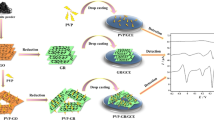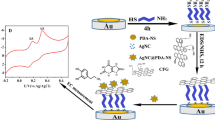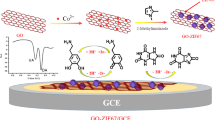Abstract
A new strategy based on gold nanoparticles (AuNPs), poly(2,6-pyridinedicarboxylic acid) (P(PDA)), and a graphene oxide (GO)-modified glassy carbon electrode (GCE/AuNPs/P(PDA)-GO) for the simultaneous electrochemical determination of ascorbic acid (AA), dopamine (DA), and uric acid (UA) was proposed in this study. The composite electrode was characterized using scanning electron microscopy (SEM), X-ray photoelectron spectroscopy (XPS), cyclic voltammetry (CV), electrochemical impedance spectroscopy (EIS), and differential pulse voltammetry (DPV). The GCE/AuNPs/P(PDA)/GO exhibited good electrochemical behavior towards the electrocatalysis of AA, DA, and UA due to the synergistic effects between P(PDA), GO, and AuNPs. The electro-oxidation signals appeared as three clearly seperated peaks with remarkable peak potential differences of 0.161 V (AA–DA), 0.336 V (AA–UA), and 0.175 V (DA–UA). The linear responses of AA, DA, and UA were in the concentration ranges of 6.0 to 2400.0, 0.05 to 100.0, and 0.5 to 150.0 µmol L‒1 with the detection limits of 1.764, 0.017, and 0.160 µmol L‒1, respectively. The sensor was used for the voltammetric determination of AA, DA, and UA in human urine samples using the standard addition method with satisfactory results.
Graphical abstract







Similar content being viewed by others
References
Zhang M, Liu K, Xiang L, Lin Y, Su L, Mao L (2007) Carbon nanotube-modified carbon fiber microelectrodes for in vivo voltammetric measurement of ascorbic acid in rat brain. Anal Chem 79(17):6559–6565. doi:10.1021/ac0705871
Motahary M, Ghoreishi SM, Behpour M, Golestaneh M (2010) Electrochemical determination of ascorbic acid at the surface of a graphite electrode modified with multi-walled carbon nanotubes/tetradecyltrimethylammonium bromide. J Appl Electrochem 40(4):841–847. doi:10.1007/s10800-009-0067-0
Wightman RM, May LJ, Michael AC (1988) Detection of dopamine dynamics in the brain. Analytical Chemistry 60(13):769A–779 A. doi:10.1021/ac00164a001
Liu X, Zhang L, Wei S, Chen S, Ou X, Lu Q (2014) Overoxidized polyimidazole/graphene oxide copolymer modified electrode for the simultaneous determination of ascorbic acid, dopamine, uric acid, guanine and adenine. Biosens Bioelectron 57:232–238. doi:10.1016/j.bios.2014.02.017
Niu X, Yang W, Guo H, Ren J, Yang F, Gao J (2012) A novel and simple strategy for simultaneous determination of dopamine, uric acid and ascorbic acid based on the stacked graphene platelet nanofibers/ionic liquids/chitosan modified electrode. Talanta 99:984–988. doi:10.1016/j.talanta.2012.07.077
Zhang G, He P, Feng W, Ding S, Chen J, Li L, He H, Zhang S, Dong F (2016) Carbon nanohorns/poly(glycine) modified glassy carbon electrode: Preparation, characterization and simultaneous electrochemical determination of uric acid, dopamine and ascorbic acid. J Electroanal Chem 760:24–31. doi:10.1016/j.jelechem.2015.11.035
Ramesh P, Suresh GS, Sampath S (2004) Selective determination of dopamine using unmodified, exfoliated graphite electrodes. J Electroanal Chem 561:173–180. doi:10.1016/j.jelechem.2003.08.002
Wang Y, Bi C (2013) Simultaneous electrochemical determination of ascorbic acid, dopamine and uric acid using poly (tyrosine)/functionalized multi-walled carbon nanotubes composite film modified electrode. J Mol Liq 177:26–31. doi:10.1016/j.molliq.2012.10.009
Wang Y (2011) Simultaneous determination of uric acid, xanthine and hypoxanthine at poly(pyrocatechol violet)/functionalized multi-walled carbon nanotubes composite film modified electrode. Colloids Surf B 88(2):614–621. doi:10.1016/j.colsurfb.2011.07.051
Ergün E, Kart Ş, Zeybek DK, Zeybek B (2016) Simultaneous electrochemical determination of ascorbic acid and uric acid using poly(glyoxal-bis(2-hydroxyanil)) modified glassy carbon electrode. Sens Actuators B 224:55–64. doi:10.1016/j.snb.2015.10.032
Troiani EdP, Faria RC (2013) Cathodically pretreated poly(1-aminoanthraquinone)-modified electrode for determination of ascorbic acid, dopamine, and uric acid. J Appl Electrochem 43(9):919–926. doi:10.1007/s10800-013-0577-7
Cobley CM, Chen J, Cho EC, Wang LV, Xia Y (2011) Gold nanostructures: a class of multifunctional materials for biomedical applications. Chem Soc Rev 40(1):44–56. doi:10.1039/B821763G
Thiagarajan S, Chen S-M (2007) Preparation and characterization of PtAu hybrid film modified electrodes and their use in simultaneous determination of dopamine, ascorbic acid and uric acid. Talanta 74(2):212–222. doi:10.1016/j.talanta.2007.05.049
Huang J, Liu Y, Hou H, You T (2008) Simultaneous electrochemical determination of dopamine, uric acid and ascorbic acid using palladium nanoparticle-loaded carbon nanofibers modified electrode. Biosens Bioelectron 24(4):632–637. doi:10.1016/j.bios.2008.06.011
Latif-ur-Rahman, Shah A, Khan SB, Asiri AM, Hussain H, Han C, Qureshi R, Ashiq MN, Zia MA, Ishaq M, Kraatz H-B (2015) Synthesis, characterization, and application of Au–Ag alloy nanoparticles for the sensing of an environmental toxin, pyrene. J Appl Electrochem 45(5):463–472. doi:10.1007/s10800-015-0807-2
Rahman L-u, Shah A, Lunsford SK, Han C, Nadagouda MN, Sahle-Demessie E, Qureshi R, Khan MS, Kraatz H-B, Dionysiou DD (2015) Monitoring of 2-butanone using a Ag-Cu bimetallic alloy nanoscale electrochemical sensor. RSC Adv 5(55):44427–44434. doi:10.1039/C5RA03633J
Latif-ur-Rahman, Shah A, Qureshi R, Khan SB, Asiri AM, Shah A-u-HA, Ishaq M, Khan MS, Lunsford SK, Zia MA (2015) Spectroscopic Analysis of Au-Cu Alloy Nanoparticles of Various Compositions Synthesized by a Chemical Reduction Method. Adv Mater Sci Eng. doi:10.1155/2015/638629
Cui R, Wang X, Zhang G, Wang C (2012) Simultaneous determination of dopamine, ascorbic acid, and uric acid using helical carbon nanotubes modified electrode. Sens Actuators B 161(1):1139–1143. doi:10.1016/j.snb.2011.11.040
Zhou M, Guo S (2015) Electrocatalytic Interface Based on Novel Carbon Nanomaterials for Advanced Electrochemical Sensors. ChemCatChem 7(18):2744–2764. doi:10.1002/cctc.201500198
Du J, Yue R, Ren F, Yao Z, Jiang F, Yang P, Du Y (2013) Simultaneous determination of uric acid and dopamine using a carbon fiber electrode modified by layer-by-layer assembly of graphene and gold nanoparticles. Gold Bull 46(3):137–144. doi:10.1007/s13404-013-0090-0
Cui F, Zhang X (2012) Electrochemical sensor for epinephrine based on a glassy carbon electrode modified with graphene/gold nanocomposites. J Electroanal Chem 669:35–41. doi:10.1016/j.jelechem.2012.01.021
Chen X, Zhang G, Shi L, Pan S, Liu W, Pan H (2016) Au/ZnO hybrid nanocatalysts impregnated in N-doped graphene for simultaneous determination of ascorbic acid, acetaminophen and dopamine. Mater Sci Eng 65:80–89. doi:10.1016/j.msec.2016.03.106
Johra FT, Lee J-W, Jung W-G (2014) Facile and safe graphene preparation on solution based platform. J Ind Eng Chem 20(5):2883–2887. doi:10.1016/j.jiec.2013.11.022
Si W, Lei W, Zhang Y, Xia M, Wang F, Hao Q (2012) Electrodeposition of graphene oxide doped poly(3,4-ethylenedioxythiophene) film and its electrochemical sensing of catechol and hydroquinone. Electrochim Acta 85:295–301. doi:10.1016/j.electacta.2012.08.099
Wang H, Hao Q, Yang X, Lu L, Wang X (2009) Graphene oxide doped polyaniline for supercapacitors. Electrochem Commun 11(6):1158–1161. doi:10.1016/j.elecom.2009.03.036
Kesavan S, Abraham John S (2016) Stable determination of paracetamol in the presence of uric acid in human urine sample using melamine grafted graphene modified electrode. J Electroanal Chem 760:6–14. doi:10.1016/j.jelechem.2015.11.039
Zhang D, Li L, Ma W, Chen X, Zhang Y (2017) Electrodeposited reduced graphene oxide incorporating polymerization of l-lysine on electrode surface and its application in simultaneous electrochemical determination of ascorbic acid, dopamine and uric acid. Mater Sci Eng 70(Part 1):241–249. doi:10.1016/j.msec.2016.08.078
Tığ GA, Zeybek B, Pekyardımcı Ş (2016) Electrochemical DNA biosensor based on poly(2,6-pyridinedicarboxylic acid) modified glassy carbon electrode for the determination of anticancer drug gemcitabine. Talanta 154:312–321. doi:10.1016/j.talanta.2016.03.049
Cui L, Ai S, Shang K, Meng X, Wang C (2011) Electrochemical determination of NADH using a glassy carbon electrode modified with Fe3O4 nanoparticles and poly-2,6-pyridinedicarboxylic acid, and its application to the determination of antioxidant capacity. Microchimica Acta 174(1):31–39. doi:10.1007/s00604-011-0594-3
Pham TA, Kim JS, Kim JS, Jeong YT (2011) One-step reduction of graphene oxide with l-glutathione. Colloids Surf A 384(1–3):543–548. doi:10.1016/j.colsurfa.2011.05.019
Saberi R-S, Shahrokhian S, Marrazza G (2013) Amplified electrochemical DNA sensor based on polyaniline film and gold nanoparticles. Electroanalysis 25(6):1373–1380. doi:10.1002/elan.201200434
Hui N, Wang S, Xie H, Xu S, Niu S, Luo X (2015) Nickel nanoparticles modified conducting polymer composite of reduced graphene oxide doped poly(3,4-ethylenedioxythiophene) for enhanced nonenzymatic glucose sensing. Sens Actuators B 221:606–613. doi:10.1016/j.snb.2015.07.011
Ahammad AJS, Rahman MM, Xu G-R, Kim S, Lee J-J (2011) Highly sensitive and simultaneous determination of hydroquinone and catechol at poly(thionine) modified glassy carbon electrode. Electrochim Acta 56(14):5266–5271. doi:10.1016/j.electacta.2011.03.004
Zhao S, Zhang K, Bai Y, Yang W, Sun C (2006) Glucose oxidase/colloidal gold nanoparticles immobilized in Nafion film on glassy carbon electrode: direct electron transfer and electrocatalysis. Bioelectrochemistry 69(2):158–163. doi:10.1016/j.bioelechem.2006.01.001
Wang J (2006) Study of electrode reactions and interfacial properties. In: Analytical electrochemistry, Wiley, Hoboken, pp 29–66. doi:10.1002/0471790303.ch2
Yao Y, Shiu K-K (2007) Electron-transfer properties of different carbon nanotube materials, and their use in glucose biosensors. Anal Bioanal Chem 387(1):303–309. doi:10.1007/s00216-006-0924-1
Istrate O-M, Rotariu L, Marinescu VE, Bala C (2016) NADH sensing platform based on electrochemically generated reduced graphene oxide–gold nanoparticles composite stabilized with poly(allylamine hydrochloride). Sens Actuators B 223:697–704. doi:10.1016/j.snb.2015.09.142
Yang J, Yang T, Feng Y, Jiao K (2007) A DNA electrochemical sensor based on nanogold-modified poly-2,6-pyridinedicarboxylic acid film and detection of PAT gene fragment. Anal Biochem 365(1):24–30. doi:10.1016/j.ab.2006.12.039
Liu X, Ou X, Lu Q, Zhang J, Chen S, Wei S (2014) Electrochemical sensor based on overoxidized dopamine polymer and 3,4,9,10-perylenetetracarboxylic acid for simultaneous determination of ascorbic acid, dopamine, uric acid, xanthine and hypoxanthine. RSC Adv 4(80):42632–42637. doi:10.1039/C4RA05853D
Wang C, Zou X, Zhao X, Wang Q, Tan J, Yuan R (2015) Cu-nanoparticles incorporated overoxidized-poly(3-amino-5-mercapto-1,2,4-triazole) film modified electrode for the simultaneous determination of ascorbic acid, dopamine, uric acid and tryptophan. J Electroanal Chem 741:36–41. doi:10.1016/j.jelechem.2015.01.014
Hu G, Ma Y, Guo Y, Shao S (2008) Electrocatalytic oxidation and simultaneous determination of uric acid and ascorbic acid on the gold nanoparticles-modified glassy carbon electrode. Electrochim Acta 53(22):6610–6615. doi:10.1016/j.electacta.2008.04.054
Zhao Y, Gao Y, Zhan D, Liu H, Zhao Q, Kou Y, Shao Y, Li M, Zhuang Q, Zhu Z (2005) Selective detection of dopamine in the presence of ascorbic acid and uric acid by a carbon nanotubes-ionic liquid gel modified electrode. Talanta 66(1):51–57. doi:10.1016/j.talanta.2004.09.019
Tian X, Cheng C, Yuan H, Du J, Xiao D, Xie S, Choi MMF (2012) Simultaneous determination of l-ascorbic acid, dopamine and uric acid with gold nanoparticles–β-cyclodextrin–graphene-modified electrode by square wave voltammetry. Talanta 93:79–85. doi:10.1016/j.talanta.2012.01.047
Mocak J, Bond AM, Mitchell S, Scollary G (1997) A statistical overview of standard (IUPAC and ACS) and new procedures for determining the limits of detection and quantification: application to voltammetric and stripping techniques (Technical Report). Pure Appl Chem, 69. doi:10.1351/pac199769020297
Wang C, Du J, Wang H, Zou Ce, Jiang F, Yang P, Du Y (2014) A facile electrochemical sensor based on reduced graphene oxide and Au nanoplates modified glassy carbon electrode for simultaneous detection of ascorbic acid, dopamine and uric acid. Sens Actuators B 204:302–309. doi:10.1016/j.snb.2014.07.077
Wang S, Zhang W, Zhong X, Chai Y, Yuan R (2015) Simultaneous determination of dopamine, ascorbic acid and uric acid using a multi-walled carbon nanotube and reduced graphene oxide hybrid functionalized by PAMAM and Au nanoparticles. Anal Methods 7(4):1471–1477. doi:10.1039/C4AY02086C
Yan J, Liu S, Zhang Z, He G, Zhou P, Liang H, Tian L, Zhou X, Jiang H (2013) Simultaneous electrochemical detection of ascorbic acid, dopamine and uric acid based on graphene anchored with Pd–Pt nanoparticles. Colloids Surf B 111:392–397. doi:10.1016/j.colsurfb.2013.06.030
Yang YJ, Li W (2014) CTAB functionalized graphene oxide/multiwalled carbon nanotube composite modified electrode for the simultaneous determination of ascorbic acid, dopamine, uric acid and nitrite. Biosens Bioelectron 56:300–306. doi:10.1016/j.bios.2014.01.037
Yao H, Sun Y, Lin X, Tang Y, Huang L (2007) Electrochemical characterization of poly(eriochrome black T) modified glassy carbon electrode and its application to simultaneous determination of dopamine, ascorbic acid and uric acid. Electrochim Acta 52(20):6165–6171. doi:10.1016/j.electacta.2007.04.013
Zhang X, Zhang Y-C, Ma L-X (2016) One-pot facile fabrication of graphene-zinc oxide composite and its enhanced sensitivity for simultaneous electrochemical detection of ascorbic acid, dopamine and uric acid. Sens Actuators B 227:488–496. doi:10.1016/j.snb.2015.12.073
Zhao D, Yu G, Tian K, Xu C (2016) A highly sensitive and stable electrochemical sensor for simultaneous detection towards ascorbic acid, dopamine, and uric acid based on the hierarchical nanoporous PtTi alloy. Biosens Bioelectron 82:119–126. doi:10.1016/j.bios.2016.03.074
Acknowledgements
The authors would like to thank Assoc. Prof. Dr. Bülent Zeybek for supplying graphene oxide powder. This work was supported by the Ankara University Research Fund (BAP, Grant No. 16H0430016).
Author information
Authors and Affiliations
Corresponding author
Electronic supplementary material
Below is the link to the electronic supplementary material.
Rights and permissions
About this article
Cite this article
Aydoğdu Tığ, G., Günendi, G. & Pekyardımcı, Ş. A selective sensor based on Au nanoparticles-graphene oxide-poly(2,6-pyridinedicarboxylic acid) composite for simultaneous electrochemical determination of ascorbic acid, dopamine, and uric acid. J Appl Electrochem 47, 607–618 (2017). https://doi.org/10.1007/s10800-017-1060-7
Received:
Accepted:
Published:
Issue Date:
DOI: https://doi.org/10.1007/s10800-017-1060-7




